Menu
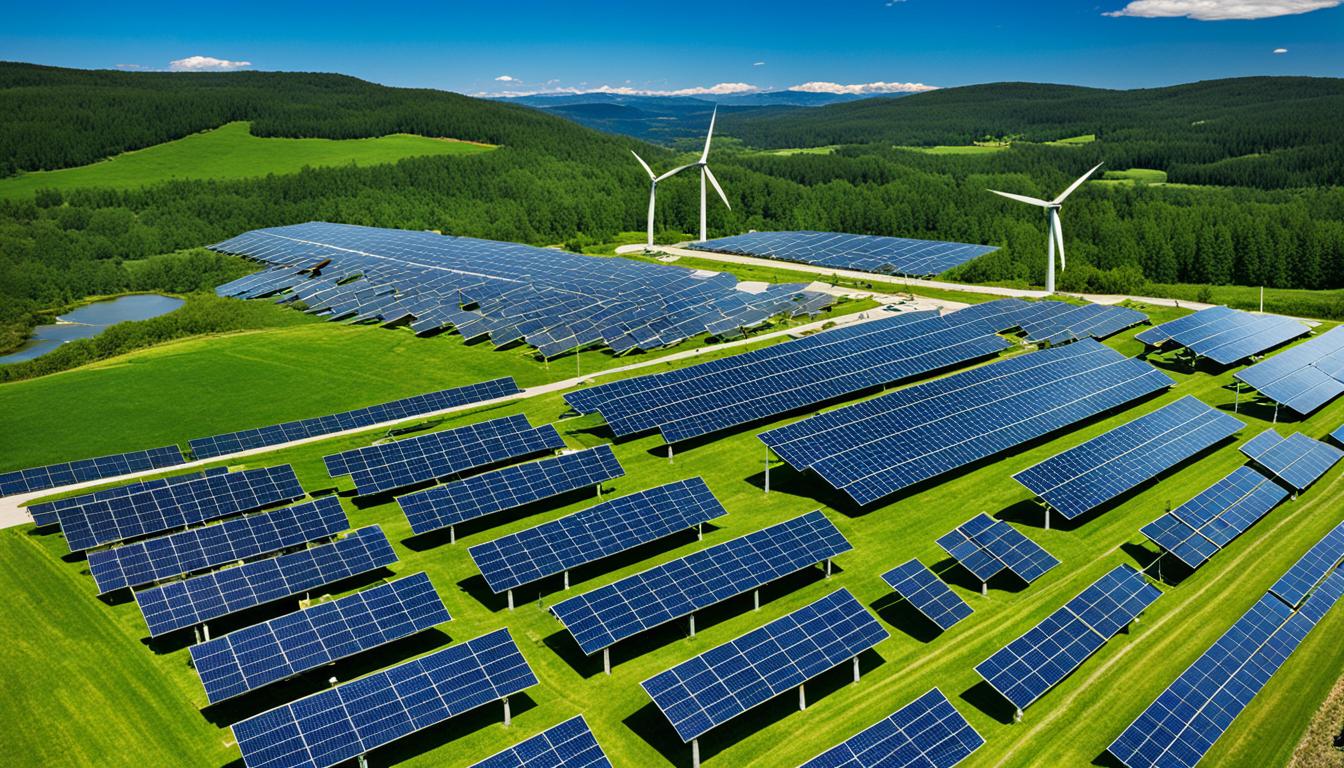
In 2023, solar and wind energy’s global capacity shot up by 50%. By the end of COP28, over 110 countries had pledged to boost their renewable power. They poured an incredible USD 1.8 trillion into this green push in just one year. These figures show just how much we can change our world by turning to solar, wind, hydro, and geothermal energy. These case studies highlight our fight against climate change, our push for better environmental health, and our move away from fossil fuels.
Renewable energy projects shine a light on how we will power our planet in the future. They help us understand green energy’s impact through detailed reports. These reports cover sustainability and environmental effects. Asset management and looking at the economic benefits are vital, along with using new technologies well. We get to see the success stories of projects like wind farms. Plus, we learn how to cut costs in areas like offshore wind. All of this information is a big help for those who invest in or make the policies for these projects.
Renewable energy, also known as green energy, is changing how we power our world. It uses natural sources like sunlight, wind, and heat from the earth. This helps us move away from using up Earth’s harmful fossil fuels. With new tech, the potential for renewable energy is huge and very exciting.
Renewable energy comes from ongoing natural processes. It’s different because it doesn’t run out like oil and coal. Thanks to new tech, we can now turn sun, wind, and earth heat into power.
Renewable energy is key in fighting climate change. It cuts down on pollution, helping the planet. Just look at Montenegro, where using more renewable energy led to a 20% drop in pollution. It also boosts the economy by creating jobs. About 35% of Montenegro’s energy comes from renewables now, showing their success.
More people are becoming energy producers. They make their own electricity from the sun and wind. This not only cuts down on long power lines but also saves a lot of energy. This way of using clean energy is a great example of how we could live in the future.
Solar energy is leading the way in renewable power. Thanks to new ideas and more people using it, the solar industry is growing fast. Today, producing solar power costs less than 20 cents per kilowatt hour in the United States, making it a smart choice for creating energy.
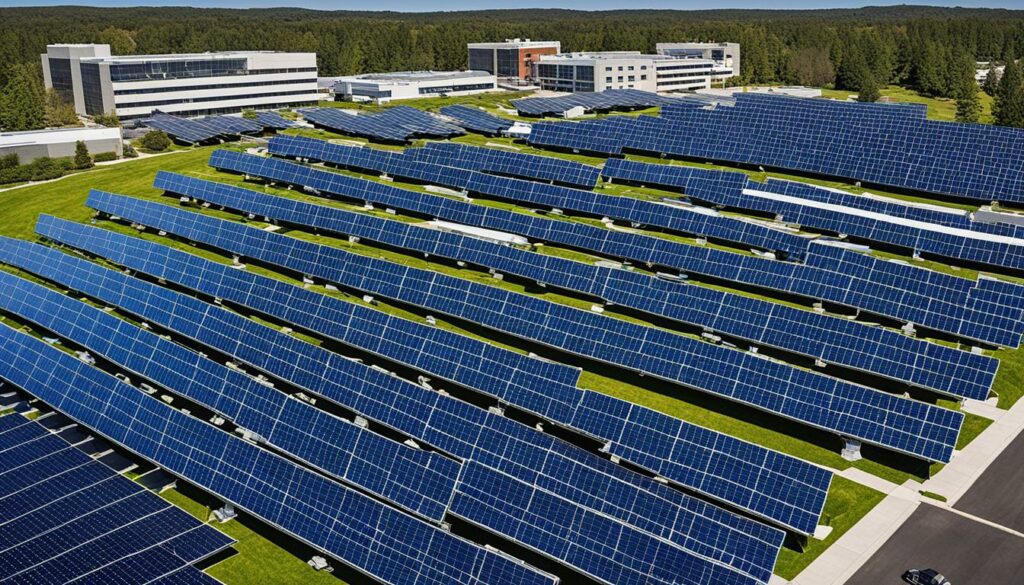
Photovoltaic (PV) systems are the most common way to make solar energy work. They change the sun’s light into electricity using panels. This approach is so flexible that we see it on small homes and big solar farms alike. In California, for example, over 112,000 houses have seen the benefits.
These systems have also helped create lots of jobs, more than 100,000 in the U.S. Programs in places like California have made it easier for families with low incomes to afford solar power. Not only does this save people money, but it also helps the environment by cutting down on greenhouse gases.
Concentrating Solar-Thermal Power (CSP) takes a unique approach. It uses mirrors to focus the sun’s rays, turning them into heat which creates electricity. This works well for making a lot of power and has seen success in many projects.
An auto shop in Ventura, for example, saw its electric bill drop by 90 percent after installing a solar system. They got help with the cost through special deals and a low-interest loan. Now, they can sell any extra power they make back to the grid.
Another company, Solar Electrical Systems, has set up CSP panels in interesting places. This includes the Huntington Library and Gardens and even at film director James Cameron’s home. This shows us how useful CSP technology can be in different places.
| Parameter | Photovoltaics (PV) | Concentrating Solar-Thermal Power (CSP) |
|---|---|---|
| Cost per kWh | Less than $0.20 | Varies based on scale |
| Main Application | Residential and Commercial | Large-scale power plants |
| Job Creation | 100,000+ jobs in the U.S. | Significant in large projects |
| Energy Efficiency Research | High priority for continual improvements | Focused on enhancing efficiency and reliability |
Wind energy is widely used as a renewable energy source. It works by turning the wind’s kinetic power into electricity. This happens with turbines. They are chosen a lot because they’re affordable to set up and are good for the environment.
Onshore wind farms are easy to get to and set up because they’re on land. They use the wind to make power. But, we need to look into how they affect the environment. This is because they can disturb wildlife. This includes birds and bats. The noise and flicker from these farms might also bother people nearby.
Offshore wind farms are built far out in the sea. This avoids the issue of being close to where people live. They make a lot of power because the winds at sea are strong and steady. But, just like onshore farms, they have to do careful checks on how they might harm the ocean and the climate.
Both onshore and offshore wind farms show how important wind energy is. Even though the wind isn’t always blowing, it’s a key way to make clean energy. It helps a lot with making power sustainably.
Hydroelectric power is a key player in the world’s green energy. It comes from the energy of moving water. Globally, it has reached over 1300 GW, making it vital in the battle against climate change. Hydropower’s growth in the next ten years could create about 600,000 jobs worldwide.
The sector needs around US$1.7 trillion for future development. This money will go into new technologies that are more flexible, sustainable, and less damaging to the environment. For instance, designs like pump-as-turbines when used as pumps and low head hydropower converters are being looked at closely. They’re part of the effort to make sustainable energy that does less harm.
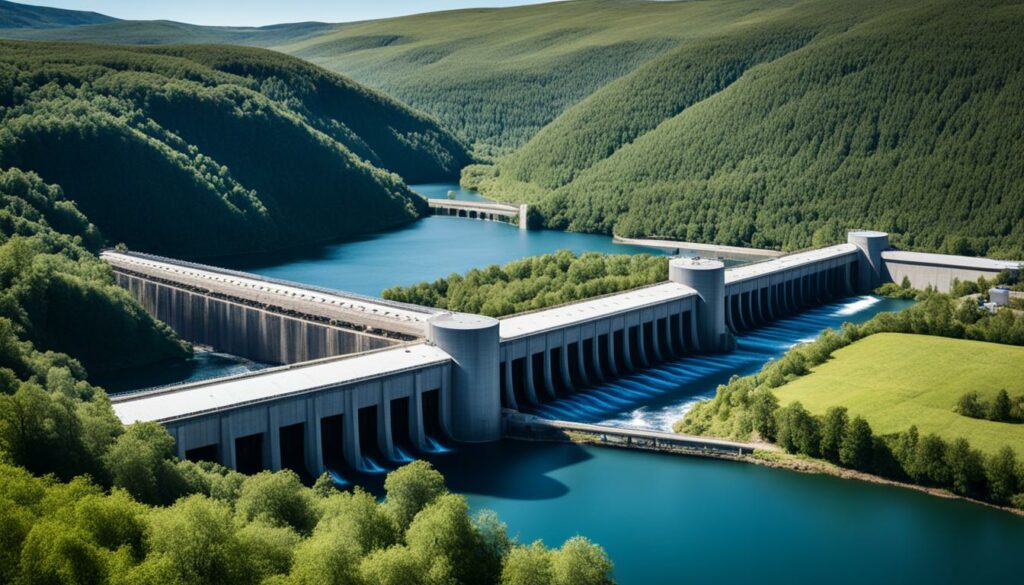
Developments are also focusing on being kinder to fish and the environment as a whole. Hydropower plants are becoming more connected digitally to lower the risk of breakdowns and work better. Providing electricity in remote areas helps support local people. A major effort is underway to find ways to make hydropower less disruptive to the environment in the long term, like reducing the effects of hydropeaking.
| Aspect | Detail |
|---|---|
| Global Capacity | Exceeds 1300 GW |
| Job Creation | 600,000 skilled jobs |
| Required Investment | US$1.7 trillion |
| Technological Innovations | Very Low Head, HPM, Vortex turbines |
| Environmental Strategies | Fish-friendly solutions, minimising hydropeaking |
| Operational Efficiency | RDF12© speed governor by CVA |
| CVA’s Contribution | Operates 32 hydroelectric plants in Aosta Valley |
Geothermal energy taps into the Earth’s heat just below its surface. It’s turned into power and heating through modern tech. This shows how we’re moving forward with renewable technology innovations and creating many clean energy success stories.
Geothermal heat pumps (GHPs) are key in geothermal tech. They take warmth from the earth to heat buildings in winter and cool them in summer. Their use everywhere helps cut down on energy use and pollution, making them stand out as clean energy success stories.
Geothermal power plants use the Earth’s thermal energy to make electricity. Examples like Iceland’s Hellisheidi plant and California’s The Geysers show big achievements, producing over 900 megawatts. Iceland is a leader, getting almost all its power from geothermal, which is big for renewable technology innovations.
Japan’s Otake plant, making 110 MW, can power many homes, serving about 100,000. Indonesia’s Sarulla plant, with a big 330 MW, is part of a goal to have 7,200 MW of geothermal power by 2025.
| Country | Major Geothermal Projects | Capacity (MW) | Notable Achievements |
|---|---|---|---|
| Iceland | Hellisheidi Plant | 303 | Nearly 100% electricity from geothermal sources |
| USA | The Geysers Complex | 900+ | Largest geothermal field, operational since 1960s |
| Japan | Otake Plant | 110 | Powers 100,000 households |
| Indonesia | Sarulla Plant | 330 | Part of 7,200 MW goal by 2025 |
| Philippines | Tiwi & Makiling-Banahaw Plants | 700+ | Second largest geothermal capacity worldwide |
| New Zealand | Wairakei Power Station | 435 | 20% of national electricity generation |
Making energy in a scattered pattern is changing how we see renewable energy. Microgrids and smart grids make energy close to where it’s used. They also work better, use energy more wisely, and are easier to change. Because of these factors, they are becoming key in moving to clean energy.
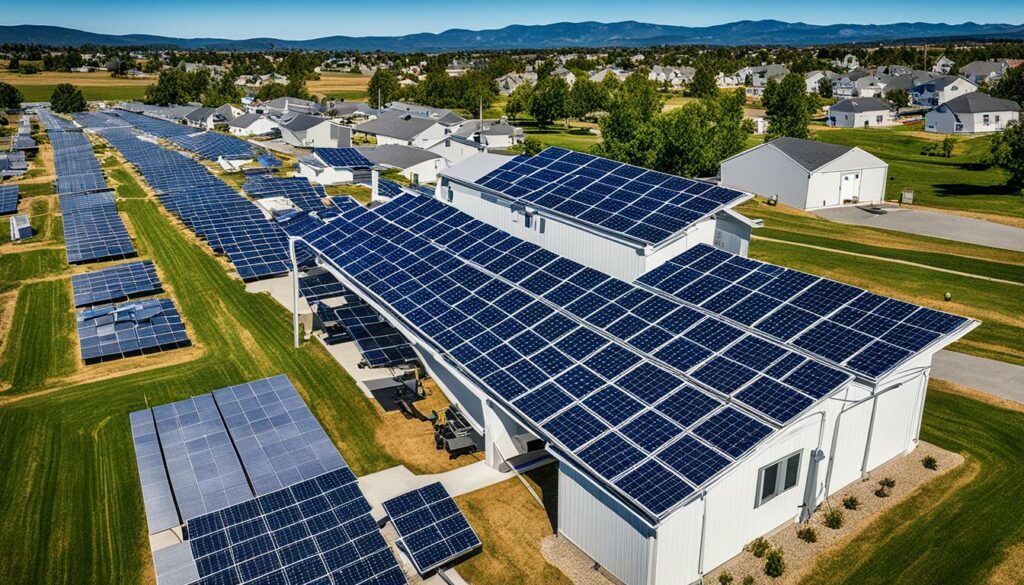
Spreading out energy sources has many good points. Microgrids are good because they keep the power on during tough times or nature’s fury. They also mean we’re not as dependent on big power plants that can stop working for many people at once. This setup makes it easier to use things like wind and solar power alongside new ways to store energy.
Here are a few cases where decentralised energy has done well:
These situations show that decentralised energy systems cut climate damage and make our energy setup stronger. For more info on these cases, look at the Smart Grids in Canada case study.
Iceland is a leader in renewable energy, producing almost all its electricity from renewable energy sources. This shows a big switch from using fossil fuels to sustainable solutions. The move to geothermal energy for heating saved Iceland a lot of money. In 2018, this saving was equal to 3.5% of the country’s GDP.
The work in geothermal energy in Iceland has not just stayed local. Since 1979, over 1,000 experts from around the world have trained in Iceland. Plus, more than 50 countries have used Icelandic know-how in their own geothermal projects. This shows how much Iceland’s work in geothermal energy has influenced the globe.
A great example is a huge geothermal heating project in China. It was built with help from Iceland and now provides heat to over 1 million people. This project is a shining example of how well Iceland has shared its sustainability reports and practices.
| Aspect | Iceland | Global Context |
|---|---|---|
| Geothermal Energy Share | 85%+ of electricity | 3,722 MW (U.S. leading) |
| Geothermal Heating in Households | 90% | 25% suitable areas in Europe |
| Renewables in Total Energy Use | 90% in 2020 | Expected rise to 8% by 2035 (OECD) |
The 2008 global financial crisis hit Iceland hard, making geothermal energy maintenance more costly. Icelandic companies overcame this by innovating. This event showed the world the power of their industrial clusters, boosting productivity and innovation in geothermal energy.
Portugal stands out in the green energy field, achieving amazing milestones in renewable energy. By 2020, EDP, Portugal’s top power company, made over 70% of its power from renewables. This shows Portugal’s strong focus on the environment and using renewable sources.
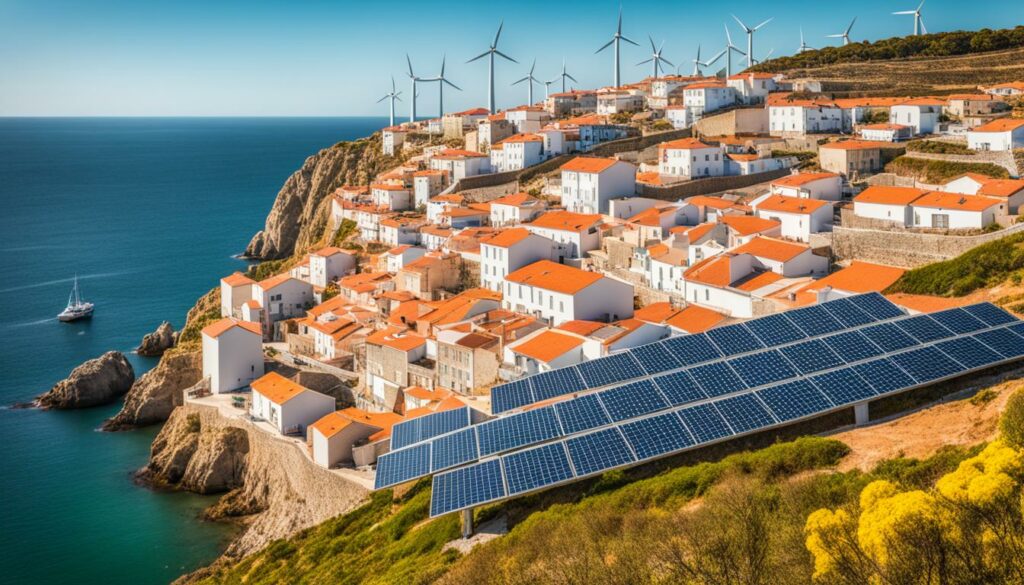
From 2006, EDP has put more than €20 billion into renewable energy, mostly in onshore wind. A lot of this money, about 40%, has gone to the U.S. through its branch, EDPR. Their big investments have upped their renewable energy ability to 79%. In 2020, 74% of the power they generated was from renewable sources. This approach proves that planned efforts in the environment lead to sustainable growth.
EDP wants to get to zero carbon emissions by 2030 and stop using coal by 2025. They’ve had a lot of help from their customers. These customers have helped avoid 1.4 million tons of CO2 and saved 3.6 trillion watt-hours since 2015. Plus, EDP is working on lower carbon uses, lowering some of their emissions a lot.
EDP is not stopping there. They’re adding 100,000 new spots to charge electric cars and are switching their own cars to electric. They’re also putting smart meters all over the Iberian Peninsula. This shows their commitment to updating how they use energy and to be more efficient.
EDP also cares about having more women in charge and helping in their communities. They want 30% of their leaders to be women by 2025, and 35% by 2030. They have a Volunteering Programme that many have joined. Together, they’ve done over 293,000 hours of volunteer work. They’ve helped over 1.4 million people too.
Portugal’s great strides in green energy are thanks to projects like EDP’s. Their all-round efforts in the environment and society make them a leading model in green energy. EDP’s work not only helps the planet but also brings benefits to people in many ways. Other energy companies can learn a lot from their approach.
Uruguay has done an amazing job changing to green energy. It’s a great example of how to use clean tech and policies. In 2007, it had almost no wind power. But by 2015, it had 581 megawatts of wind energy. This big change happened because the government and private sector worked together.
Wind energy was key. It made 17 percent of Uruguay’s power in 2015. The country wanted 38 percent of its power from wind by late 2017. In 2014, Uruguay added more wind power per person than any other country. This action really helped cut pollution from making electricity.
The money part also helped a lot. Over $1 billion is invested in clean energy there every year. By 2013, Uruguay got the most clean energy money compared to its size. Some help came from the Global Environment Facility, which gave $1 million. Then, the country’s own budget added $6 million. With this start, private companies also put in lots of money.
At first, Uruguay wanted 300 MW of wind by 2015. But the plan went so well, they aimed for 500 MW instead. This change and building around 50 wind farms made Uruguay’s energy cleaner.
There’s more demand for power in Uruguay now because more people are in the middle class. About 60% of the people there belong to the middle class. This growth has brought new jobs. Close to 50,000 people got work thanks to green energy. It also helped lower extreme poverty a lot.
Uruguay hasn’t just used wind. It’s also investing in solar. In 2013, the country started a plan to make 200MW of solar power. The La Jacinta project used $102 million. The Canadian Climate Fund added $25 million. This public-private effort has made a big change. Now, other solar projects help too. They’ve created many jobs and lower a lot of CO2 each year.
Uruguay is leading the way in using clean energy. It’s showing the rest of the world what’s possible.
| Year | Wind Capacity (MW) | Percentage of Electricity Generation | Solar Projects | Clean Energy Investments |
|---|---|---|---|---|
| 2007 | 0 | 0% | – | – |
| 2013 | – | – | 200MW Solar PV Tender | Largest share of GDP |
| 2014 | 581 MW | – | – | – |
| 2015 | 581 MW | 17% | La Jacinta Project ($102M) | $1 billion annually |
| 2017 | Projected 38% | – | – | – |
| 2020 | – | 98% renewables | – | – |
Using sustainable energy initiatives and renewable technology innovations is key. They help push renewable energy forward. Artificial intelligence (AI) and the Internet of Things (IoT) play a big part. They boost how well renewable energy systems work. And they cut down on costs. For example, AI can tell us when wind turbines need maintenance. This keeps everything running smoothly and makes more energy.
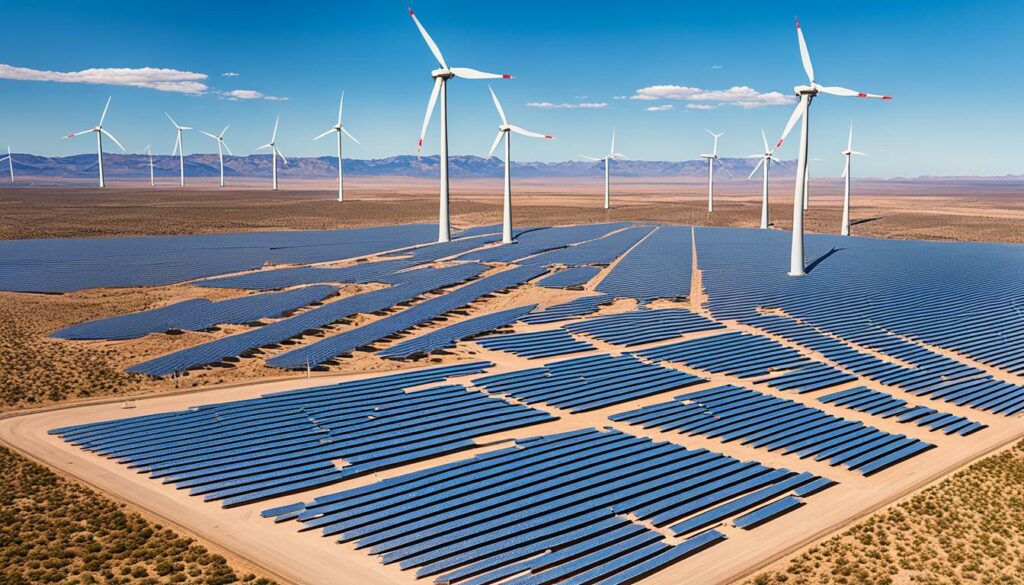
Energy storage developments are also crucial. They let us store extra energy made when it’s sunny or windy. This stored energy can be used later when not much energy is being made. Technologies like lithium-ion batteries and new ones such as solid-state batteries are improving how we store energy. This makes renewable energy systems more reliable and efficient. Also, technologies that help connect these energy systems to power grids ensure electricity is delivered where it’s needed quickly and effectively.
tVarious case studies on renewable energy deployment show the real gains of using advanced technology with sustainable energy.
Another significant development is how we think about creating new things. We’ve moved from a one-step-at-a-time method to a more interconnected way. This change is shown in Figure 5. It tells us we need to use many technologies together. This is to make a strong and lasting energy system.
Managing data well is crucial for these technologies. Data from how things are working, deals with companies, and research all help improve renewable energy technology. Big companies like Tesla and Siemens use this data. They do it to make their energy solutions better. This way, they meet what people want and the latest technology.
| Key Areas | Technological Innovations | Impact |
|---|---|---|
| Wind Energy | AI Predictive Maintenance | Enhanced Efficiency |
| Solar Energy | IoT-Driven Performance Monitoring | Cost Reduction |
| Grid Integration | Advanced Storage Solutions | Increased Reliability |
Renewable energy is changing how we make things and grow food. It’s making big strides in using energy better and fighting climate change. So, this new way doesn’t just protect our planet; it also helps our pockets.
Solar-powered systems are changing how we water crops, especially in places like Zambia. They bring many benefits, like lower costs and better use of water. In Zambia, these systems have cut water waste by 20%. They’ve also boosted crop growth thanks to better watering methods.
These changes are more than just about money. They also cut down on harmful gases, helping our planet fight climate change.
| Country | Benefits | Impact |
|---|---|---|
| Zambia | Reduced Water Wastage, Increased Crop Yield | Significant GHG Emissions Reduction |
Wind power is making a big difference for factories. For instance, Montenegro is using wind to power its metal works. This has cut their greenhouse gases by 20%. It also means 35% of their energy is now from wind.
Choosing to create your own electricity with wind has big savings. It cuts the need for long power lines and improves how things are made. So, renewable energy is vital for making things and growing food in a way that’s good for the Earth.
Corporations worldwide are making big moves towards renewable energy. They are doing this through Power Purchase Agreements (PPAs) and buying green power. The big increase in buying green energy in the first quarter shows a strong push towards a better, greener future.
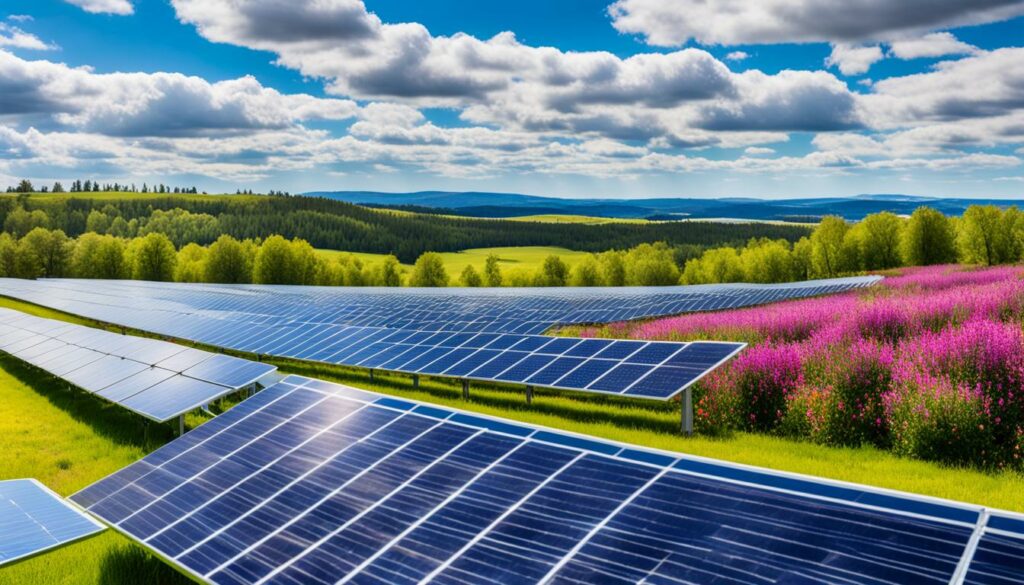
PPAs help companies get energy from green sources for the long term. General Motors (GM) is a good example. They signed PPAs to get wind energy in Mexico and Texas. Since 2015, GM saved around $80 million. This shows their real commitment to using more renewable energy.
Buying green power is also a key strategy for many big companies. Google, Microsoft, and TD Bank are leaders in this. Google has worked to be carbon neutral since 2007 with clear plans to cut emissions. Microsoft uses a carbon tax for clean tech and carbon offsets. TD Bank focuses on North American carbon offsets and funds green projects with a big part of their offset money. The Walt Disney Company does its part by taxing their emissions and investing in forests since 2008. These approaches help companies lower their carbon emissions and show green leadership in business reports.
| Company | Initiative | Result |
|---|---|---|
| General Motors | PPAs and renewable energy projects | $80 million savings over two decades; committed to 100% renewable energy by 2050 |
| Carbon neutrality initiatives since 2007 | Focused on measurable emissions reductions | |
| Microsoft | Internal carbon tax and clean tech investments | Supports impactful carbon offset projects |
| TD Bank | North American offsets and impact investing projects | Prioritises carbon neutrality and local projects |
| Walt Disney Company | Climate Solutions Fund and forestry preservation | Invests in sustainability and carbon offset |
These companies’ focus on renewable energy through PPAs and green power buying is very important. It shows they value the environment and works for a better future. Their actions not only reduce carbon footprints but also help the planet and people in many ways.
In recent years, many sustainability reports have shared insights on renewable energy. They highlight the sector’s growth and new ideas. Case studies show how different countries and groups use and gain from renewable technology innovations.
The release of A Guide to an Offshore Wind Farm in 2011 was a big step. Later versions helped by The Crown Estate showed growth in managing wind farms. They pointed out the need for better practices to earn more. Investors and stakeholders could learn how to boost their renewable projects from these.
Working with Chinese firms has boosted investments into the UK. This shows how globally the renewable energy sector is linked. Efforts to help UK ports grab more from offshore wind projects are key examples of this.
In Taiwan, the arrival of MHI Vestas was big news. It boosted the economy and set higher standards for future global investments in new renewable tech.
| Region | Key Initiative | Outcome |
|---|---|---|
| UK and Ireland | Onshore asset services analysis | Enabled market entry and efficient asset management |
| Scotland | Offshore wind supply chain support | Enhanced the capabilities and competitiveness of local businesses over five years |
| Taiwan | MHI Vestas market entry | Significant economic impact and stakeholder engagement |
| China | Policy influence from renewable electricity lessons | Shaped the development of national renewable energy policies |
An independent report on a next-gen offshore turbine was also key. It led to big talks and emphasised doing detailed checks before using large tech.
Learnings from China’s green power steps have massively shaped global policies. This has spread the good of renewable tech worldwide.
This collection of studies provides real-world stories and facts for the renewable energy industry. By turning this info into clear sustainability reports, we can make more from renewable innovation for a greener future.
The future looks bright as we make strides towards sustainability. Two key areas driving this change are improved battery storage and the growth of green hydrogen. We’re focusing on how these advancements affect the environment and lead to clean energy successes.
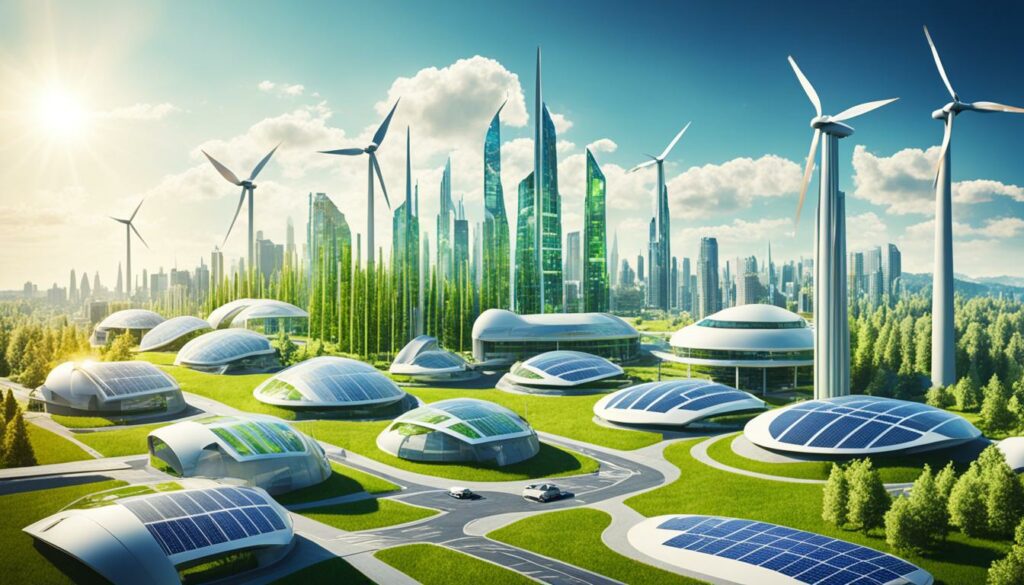
Battery storage has come a long way, boosting the reliability of renewable energy. Costs for solar power have dropped by almost 90% over the last ten years. This makes energy more accessible.From 2023 to 2028, the global capacity for renewable energy is set to rise by 7,300 gigawatts. This growth calls for better storage to manage the demand. Technologies like Tesla’s Powerpack help store extra energy. This energy is then used when there’s a high demand.Plus, using AI and in-depth analysis improves the accuracy and dependability of wind and solar power. As a result, the use of wind power is up by 15%, and solar power by 30%.
The green hydrogen economy is offering new hope for energy production and use. Green hydrogen is made by turning water into hydrogen using renewable energy. It’s a clean, zero-emission way to make hydrogen.Researchers are also making progress in turning organic material into green aviation fuels. This could cut down jet fuel emissions by up to 80%. In the US, there are plans to use offshore wind to create 30 GW of green hydrogen by 2030.
Both the advancements in battery storage and green hydrogen are rooted in careful environmental studies. These studies ensure our move towards more sustainable energy is eco-friendly. They play a big role as the world ramps up its use of renewable energy.
Renewable energy is key in tackling climate change. About 35% of the world’s greenhouse gases come from power plants. Moving to clean energy can lower this figure. China’s use of coal leads to high levels of harmful gases.
In 2018, climate-linked disasters hit 68 million people, costing $131.7 billion. This shows why we need clean energy to fight such impacts. Right now, hydropower, solar, and wind make up half of our power.
By 2040, we’ll need 56% more energy. The aim is for 90% of our power to be from green sources by 2050. This will mean big growth in renewable energy’s use.
We must also make our energy use more efficient. For example, Saudi Arabia needs to improve in the building sector, which uses lots of power. Ireland is doing well in using green energy for transport. Denmark plans to be fully green in transport with bioenergy.
| Region | Renewable Energy Share | Emission Reductions |
|---|---|---|
| Global | 14% in 2018 to 74% by 2050 | Significant decrease in greenhouse gases |
| Saudi Arabia | High energy consumption in buildings sector | Potential with renewable incorporation |
| Ireland | 15% in transportation (by 2020) | Reduced dependency on fossil fuels |
| Denmark | Goal for 100% in transportation | Transition through sustainable bioenergy |
In 2020, almost half of the money in the power sector went to green projects. Spending went up by 8% the year after. The move to cleaner tech got $1.3 trillion in 2022, a 19% increase. Renewable power is growing, now reaching almost 30% of all energy used.
Rich countries and big Asian ones are leading in using green energy. Africa is behind, with only 22% from clean sources. Better institutions are needed everywhere to tackle climate issues and boost economies, especially in Africa.
Montenegro has made big steps in using green energy. By 2021, about 35% of its energy came from green sources. This change helped cut down greenhouse gases by 20% between 2016 to 2021. The metal industry also saw benefits, using cleaner energy more efficiently.
For regular people, becoming a prosumer can be a smart move. It lets individuals make their own power, which cuts down on using imported fossil fuels. It also helps avoid losing energy when it travels long distances. Anaerobic digestion plants are better at using land for energy than other methods. This means they can make energy in a way that’s both cheap and good for the planet.
When you look at these changes from a money point of view, they make a lot of sense. Tools like net present value and benefit-cost ratio show these efforts to cut emissions are worth it. Places like the Isle of Eigg and Islay have shown the way. Technical tools and picking the right resources have been key in making these green projects work.
Green energy is key in the battle against climate change. Montenegro and other places show the big wins it can bring. With more money and better technology, we can make our future cleaner and safer.
Renewable energy comes from nature, for example, sunlight and wind. It’s different from coal or oil because it’s never-ending. Using renewables is key to fighting climate change. They also make our energy supply safer and create jobs.
It helps save our planet by reducing harmful emissions. This makes our future more secure. Using renewable sources means we don’t have to depend on limited fossil fuels. Plus, it creates many jobs and helps the economy.
Solar panels turn sunlight into electricity. Another way is to use mirrors to concentrate the sunlight. These methods work from small to large scales, at home or in big solar fields.
Wind farms on land are easy to get to and are cheaper to build. Those in the sea have more constant, powerful winds. This means they can generate more electricity. Both types help turn wind into power for us.
It uses water’s energy to make electricity. This is a big part of the world’s renewable electricity. It gives us a steady supply of energy from flowing water.
Geothermal energy is from the Earth’s heat underground. It heats and cools buildings and makes electricity too. This way, it uses the Earth’s heat for power safely and constantly.
Systems like microgrids make energy nearby, which is reliable and efficient. Smart technology helps make flexible electricity networks. This means the power is steady during hard times and we use more clean energy.
Over 85% of Iceland’s electricity comes from geothermal and other clean sources. They are showing how to use local, natural power sustainably. This makes Iceland a leader in renewable energy.
Portugal beats its own record, running fully on renewables for over six days. It aims to be carbon neutral. These goals make Portugal an example in using clean energy wisely.
By investing in solar and wind power, Uruguay is nearly 100% clean. Their fast change to green energy is remarkable. It shows their strong commitment to a sustainable future.
Tech like AI and IoT makes using renewable energy smarter and cheaper. Better ways to store and use energy are key to its success. This tech helps make clean power more efficient and available.
They are becoming important for green practices. Farms use solar to manage water better. Manufacturers use wind, reducing pollution and improving the planet.
Companies buy green energy through agreements. This helps renewable energy grow. It’s their way of supporting clean power and a green future.
We look forward to better batteries and a hydrogen economy. These new ideas will make clean energy more reliable and bigger. They are steps towards a future where we depend less on harmful fuels.
Less fossil fuel means less harm to the climate. Green energy protects nature and supports life diversity. It’s essential in our fight against global warming.